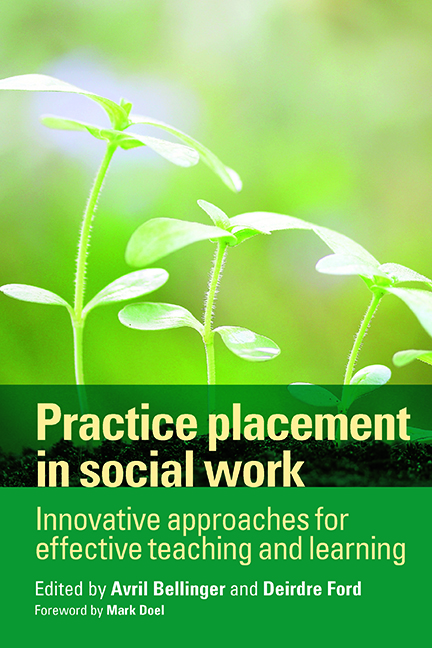Book contents
- Frontmatter
- Dedication
- Contents
- Foreword
- Notes on contributors
- Introduction
- One Student-led services
- Two International placements: learning from a distance
- Three The outside looking in – an independent social worker’s experience of practice educator work
- Four ‘Do you have to be white to pass this course?’ Developing support for black and minority ethnic students in a predominantly white area
- Five Men in social work education: building a gendered alliance
- Six Hidden in plain sight: use of an arts-based method for critical reflection
- Seven Getting our hands dirty: reconnecting social work education as if the earth matters
- Eight Social media for students in practice
- Nine Developing placement capacity in the third sector
- Ten Observations of student practice: what difference does observer qualification make?
- Eleven Filling the gap: constructive responses to the erosion of training standards for practice educators
- Twelve The concept of integrity in relation to failing and marginal students
- Thirteen Cultivating discretion: social work education in practice and the academy
- Index
Foreword
Published online by Cambridge University Press: 01 September 2022
- Frontmatter
- Dedication
- Contents
- Foreword
- Notes on contributors
- Introduction
- One Student-led services
- Two International placements: learning from a distance
- Three The outside looking in – an independent social worker’s experience of practice educator work
- Four ‘Do you have to be white to pass this course?’ Developing support for black and minority ethnic students in a predominantly white area
- Five Men in social work education: building a gendered alliance
- Six Hidden in plain sight: use of an arts-based method for critical reflection
- Seven Getting our hands dirty: reconnecting social work education as if the earth matters
- Eight Social media for students in practice
- Nine Developing placement capacity in the third sector
- Ten Observations of student practice: what difference does observer qualification make?
- Eleven Filling the gap: constructive responses to the erosion of training standards for practice educators
- Twelve The concept of integrity in relation to failing and marginal students
- Thirteen Cultivating discretion: social work education in practice and the academy
- Index
Summary
The social work placement has always been an Other Place; this is its power. When students enter a placement, they have the chance of an altered state, an experience of creativity that comes from, hopefully, a destabilising and disorienting space. That is the radical vision, so powerfully articulated in this book – to contrast with the tired cliché that the student goes on placement ‘to put into practice the knowledge they have acquired in college’, ‘theory into practice’. It is a hope for transformational learning contrasted with the passing on of existing mindsets.
More transformational still is the notion of an Other Place created by the students themselves (and, in some cases, by service users too). Rather than placements passively awaiting their apprentices or, at best, valuing the coming students as a resource, these Other Places are services generated by students to provide services that would not exist without them. Here, then, is A Place that fully integrates learning and practice through the agency of social work. Of course, these Other Places do not happen without tremendous persistence, wisdom and bravery to ensure that they are sustainable and that they are safe places, both for the student's learning and, most of all, for those who use their services.
Over the years, the happenstance that characterised the social work placement – a Nowhere Land that could be magical or dire but was always unchartered – quickly started to experience the glare of scrutiny. With this attention came audit, regulation and control; this Other Place did not escape the obsessive mapping that bisected and dissected professional life throughout the public sector. The ‘guidance’ became oppressive, the bullet-pointed lists of injunctions and imperatives longer than the placement documentation itself. Nowhere was this more strongly evidenced than in the decision about a student's ability or suitability for social work – the assessment. This decision, always complex, became deadeningly complicated.
Complication is a ball of wool that has become knotted, unravellable, unusable; complexity, on the other hand, is devising patterns and using the wool to turn these patterns into beautiful, wearable garments. Social work education will always be complex but it has become unhelpfully and tediously knotted.
- Type
- Chapter
- Information
- Practice Placement in Social WorkInnovative Approaches for Effective Teaching and Learning, pp. vii - ixPublisher: Bristol University PressPrint publication year: 2016



